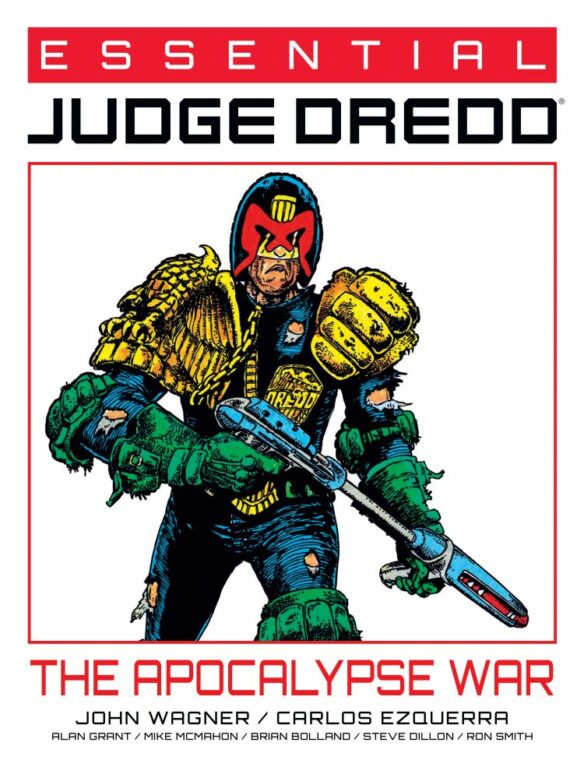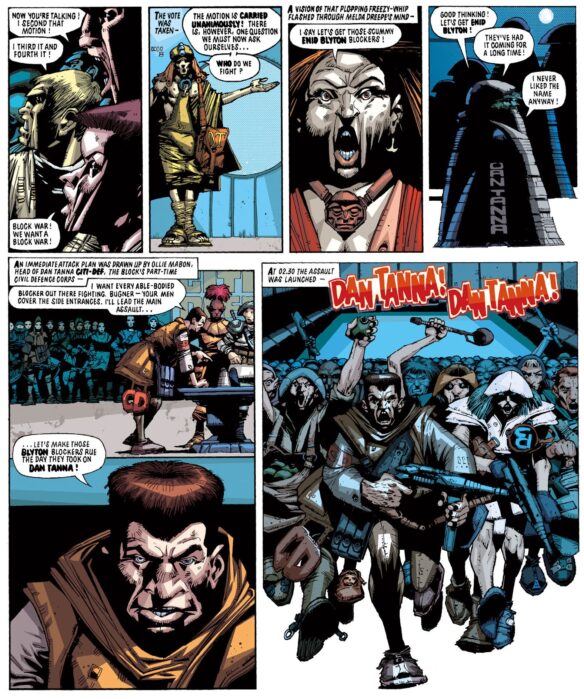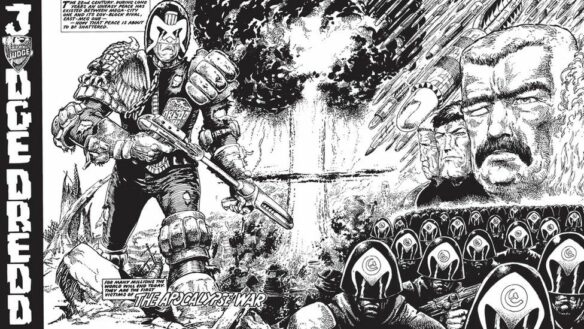[To be posted in the coming autumnal edition of SF² Concatenation in September.]

Essential Judge Dredd: The Apocalypse War
(1981 / 2022) John Wagner, Alan Grant & Carlos Ezquerra,
2000AD – Rebellion, £19.99 / Can$34 / US$25, trdpbk, 160pp,
ISBN 978-1-781-08890-6
Review by Jonathan Cowie: This is part of the relatively new Essential Judge Dredd series of graphic novels. It is a welcome reprint of a collection of one of the first Judge Dredd sagas that originally appeared in the weekly British comic 2000AD in 1982 with its prequel, “Block Mania” appearing in 1981: the stories ran consecutively. This collection features both “Block Mania” and “The Apocalypse War” and they really are a single tale.
That this is a “welcome” reprint is evidenced by this volume having had a second printing in 2022. This graphic novel is a key component to the overall Dredd plot arcs demonstrating that Dredd is not adverse to a bit of wholesale genocide if he feels it lawful.
It begins with “Block Mania” when citizens of Mega-City One’s blocks begin inter-block warfare. This was not healthy. Just as today, the US has citizen gun problems, in Mega City One the matter is compounded by each block having its own Citi Def squads – the city’s voluntary civil defense corps. The mania began with the Dan Tanna block battling Enid Blyton. But the neighboring blocks joined in taking sides. Soon there were six blocks at war with the addition of Rikki Fulton, Henry Kissinger, Betty Crocker and Pancho Villa blocks. With the Garner Ted Armstong block and others adding to the fray, soon the whole of Mega City One’s northern sectors were fighting. It was all out internecine war.

The Judges had their hands full. But then things got worse. Suddenly the Judges themselves began acting strangely and joined in! Dredd suspected that something was causing this, and he was right. Block Mania was a first strike designed to weaken Mega City One. The Diktatoriat of the Kremlin in East Meg One – the capitol city of the Sov Block was currently being led by Supreme Judge Josef Bulgarin. He and the rest of the Diktatoriat wanted to repay Mega-City One for all the so-called ‘indignities’ they had heaped on the Sov Block. They wanted Mega-City One’s “decadent citizens [to] be slaves to the might of the glorious East Meg”.
Dredd and the Judges were going to be hard pressed to defend Mega-City One and Dredd himself would ultimately have to take the war to East Meg One…

As said, this is one of the earliest Judge Dredd sagas. Much of the artwork was done by Carlos Ezquerra who co-created Dredd (specifically his visual portrayal) with John Wagner (who was more responsible for the character’s concept). The script was written by John Wagner together with Alan Grant. This was one of their early Dredd collaborations – there were eventually many, and though they had collaborated before on Dredd, I have a feeling that this was the first time that they did all of a Dredd saga together. On this occasion the writing team did so pseudonymously under the moniker T. B. Grover.
There were also artists involved with cover art. Lettering was done by the legendary Tom Frame.
Originally, when the stories were first printed in 2000AD back in 1981/2, each weekly episode was six pages long with just the first two, which covered the comic’s centrefold being in colour: the rest were black and white. (2000AD itself did not go full colour until 1991 but did have some extra colour pages before then in addition to the centrefold.) The first graphic collection of the stories, if my memory serves, was in 1984 by Titan Books. This was a two-volume set and published throughout in black and white: even what were originally the colour centrefolds were black and white in this first graphic novel edition.
Then, in 2003, Titan reprinted the saga in a single volume as a hardback and then reprinted the following year as a large format (outsized A4) paperback (allowing a rendition of the strip in approximately the same size as the original). For a while Hamlyn – Egmont took over from Titan to produce 2000AD graphic collections. When Rebellion took over publishing 2000AD from Fleetway (a part of Egmont) in 2000 (yes, in 2000AD!), they soon published their own graphic collections. Here, in the main, these Rebellion graphic novels are published in a slightly reduced-sized format, but this particular edition is different…
As mentioned earlier, this edition of The Apocalypse War is published as part of a new series called Essential Judge Dredd and is in full color and is in a slightly larger format to the usual Rebellion Judge Dredd graphic novels. So again rendition of the strip in approximately the same size as the original comic.
This Essential Judge Dredd series is a really neat idea as, as with this saga, the early Dredd stories were originally published over four decades ago. Assuming a younger reader age of say 10, that means that today, anyone under the age of 50 is unlikely to have encountered these Dredd tales the first time around (something that really ages me). Therefore these reprints are vital for the new generation of Dredd fans if they are to catch up and appreciate the character’s history and ethical background.
Finally, a word about The Apocalypse War’s social context. 2000AD writers are socially aware and were so way back when it all began in 1977. Writers John Wagner and Alan Grant (as T. B. Grover when this story was first published) regularly went through the newspapers for news stories that they could then take to the next level and satirize in a Dredd story. This is why Judge Dredd seems prescient about the slow creep of Britain towards a police state. What younger readers may not realize was the international tension in the 1960s and through to the early 1980s between the Soviet Union and NATO was palpable: there was a real threat of nuclear war. (I recall being on a bio’ geo’ fieldtrip in 1980 to hear on breakfast radio that overnight NATO had increased its Defcom status.) Today, we have climate extinction marches, but back then it was ban the bomb. Dramatized documentaries such as The War Game (1966) and the Threads (1984) film really were terrifying. This fear of nuclear war was a real cultural phenomenon and even influenced the popular music charts with things like Frankie Goes To Hollywood’s number one in the charts hit Two Tribes (1984). The original six-month run of “Block Mania”/”Apocalypse War” was conceived by Grant and Wagner as a satire on the then, and indeed current, policy of “mutually assured destruction” (MAD).
Today, with a mad man and his cronies in the Kremlin not afraid of over 100,000 casualties (so far) of his own people in pursuance of his brainless war with Ukraine for Orwellian, fictional reasons, we see an uncaring leader that very much echoes that of Supreme Judge Josef Bulgarin. When he is informed of the likely Sov casualties (up to 12%) in the early phase of the conflict, he is asked whether or not the Sov people should be informed as to what is coming and why? To which Bulgarin answers: “The people? What have they got to do with it?” It is hard not to feel that somehow Wagner and Grant got hold of a newspaper over four decades into their future…
++ Jonathan Cowie
Discover more from File 770
Subscribe to get the latest posts to your email.

I would like to think that Middenface McNulty was fighting on behalf of the Rikki Fulton Block.